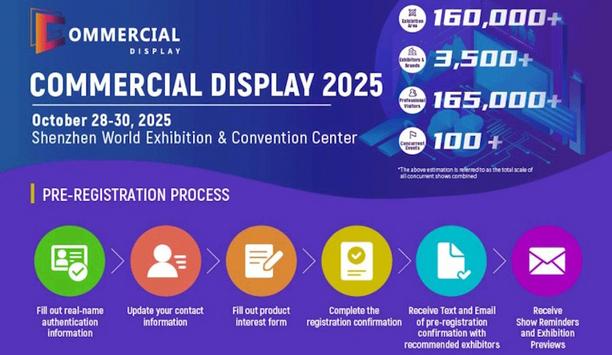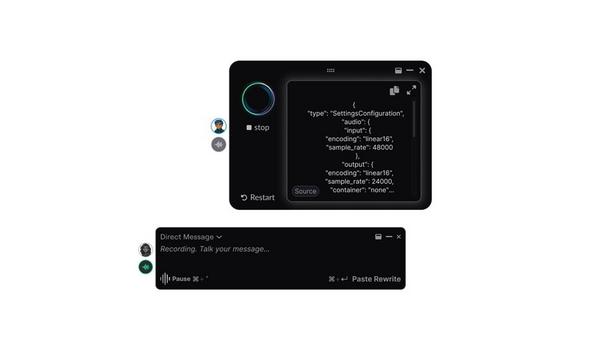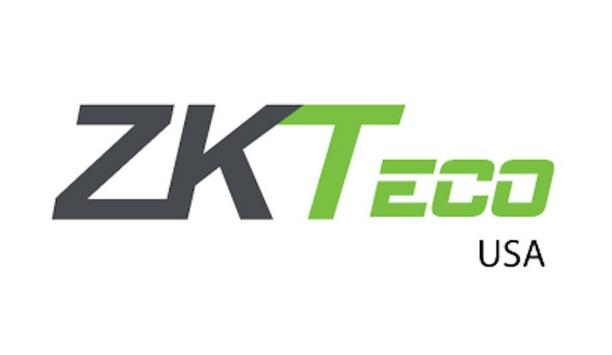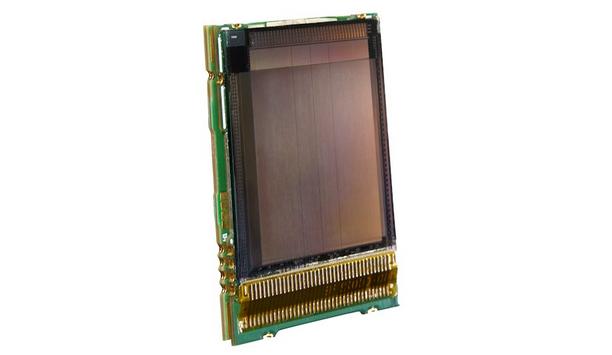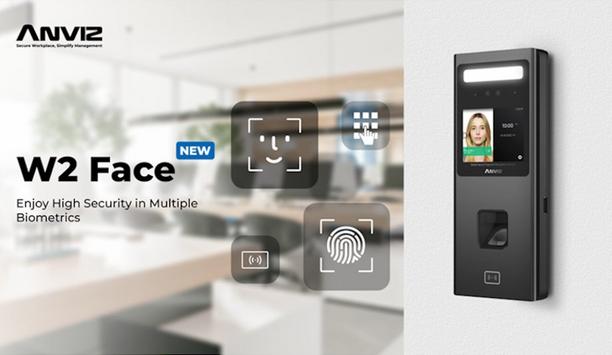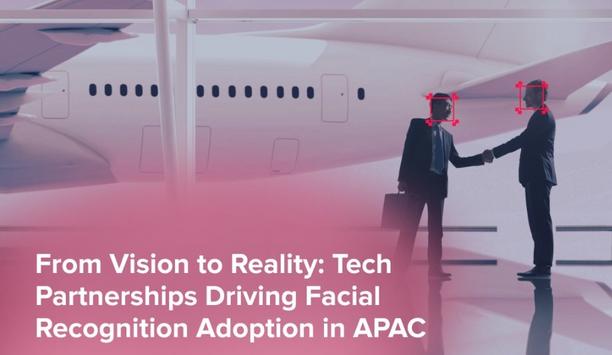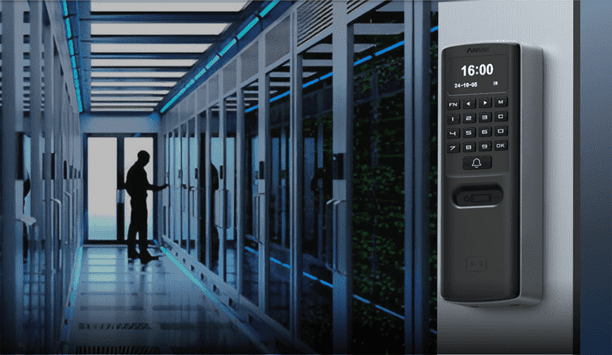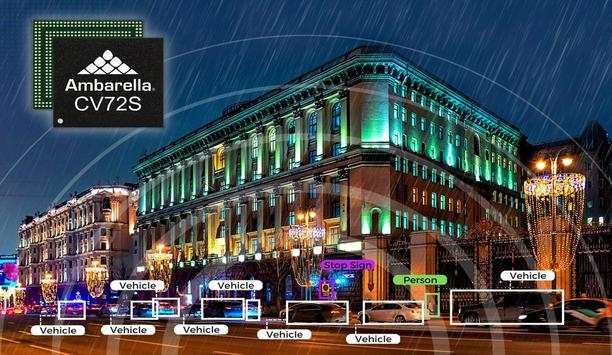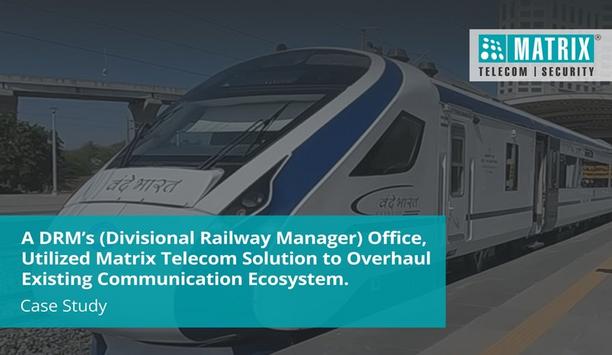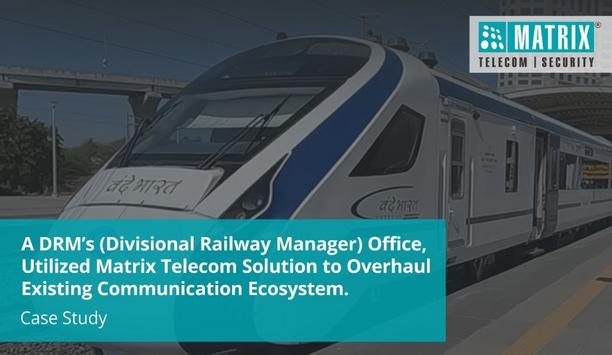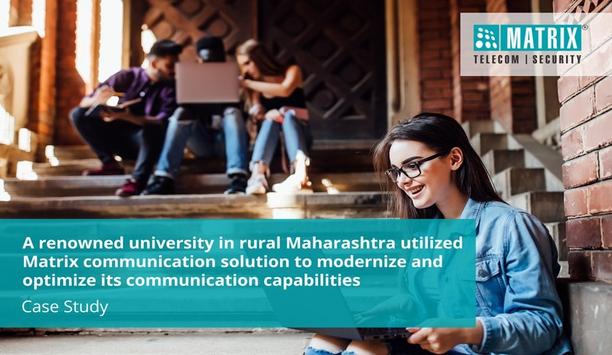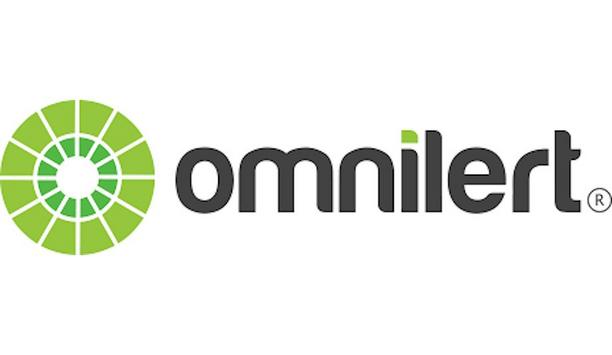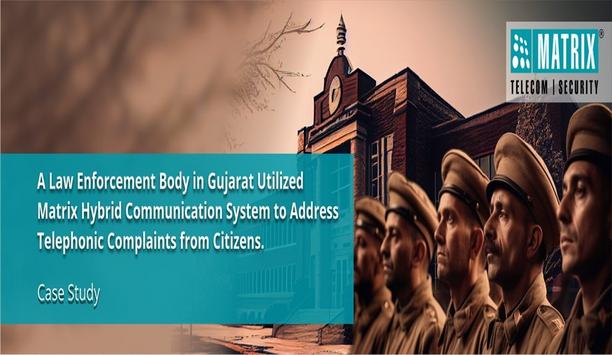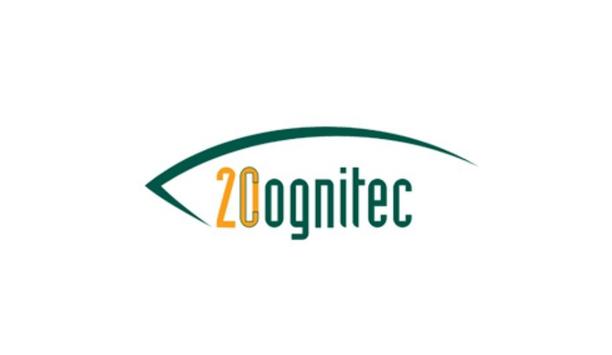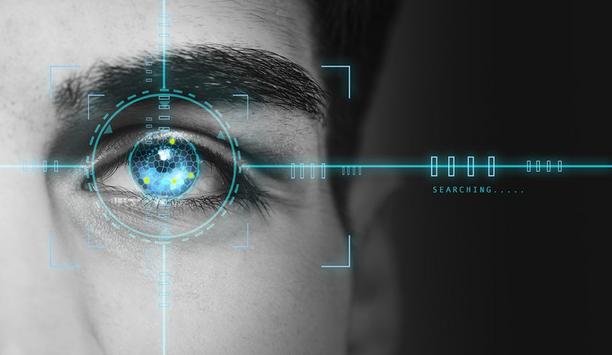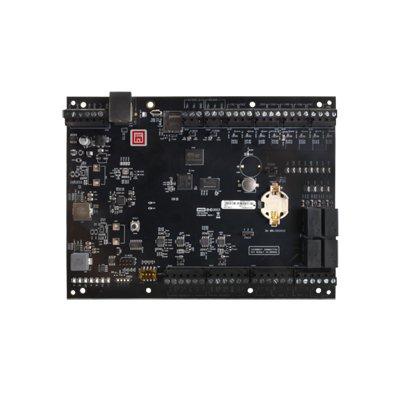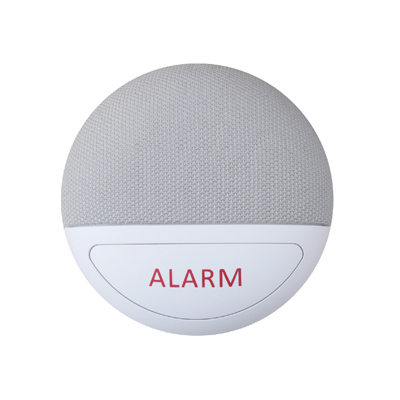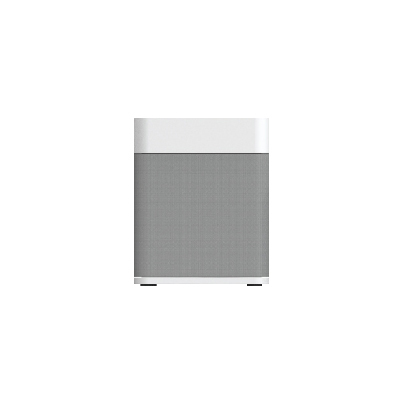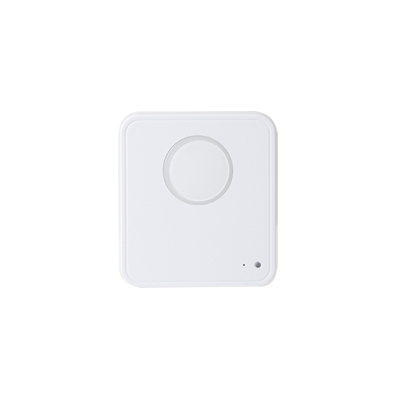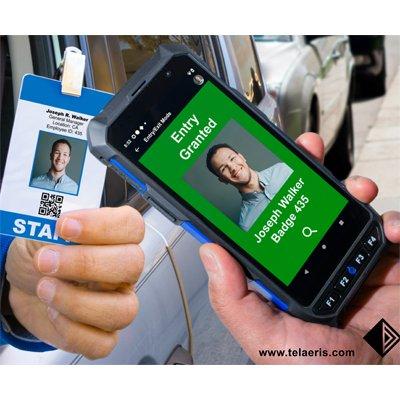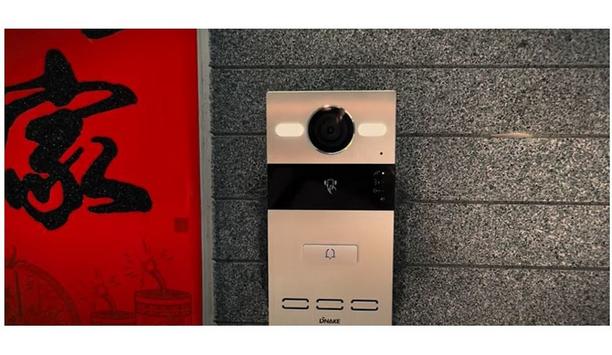Voice recognition systems
FARx, the world’s only fused-biometrics company, has launched the latest version of its software to help organizations stay ahead of AI-powered voice fraud. Advanced text-to-speech and voice cloning tools can now mimic human speech so convincingly that they are indistinguishable to the human listener, and legacy voice biometrics designed to authenticate human voices are unable to detect the difference. Recent data reveals a sharp rise in AI-related fraud, with 35% of UK businesses t...
COMMERCIAL DISPLAY 2025, Asia’s pioneering sourcing and innovation platform for smart office display solutions, interactive panels, and AI-powered conference systems, will take place at the Shenzhen World Exhibition & Convention Center. This highly anticipated event will connect global commercial display manufacturers, distributors, and technology integrators with cutting-edge solutions for the evolving workplace. From AI-driven meeting transcription and facial recognition to rea...
Deepgram, the major voice AI platform for enterprise use cases, announces the launch of Deepgram Saga, a Voice Operating System (OS) designed specifically for developers. Saga is a universal voice interface that embeds directly into developer workflows, allowing users to control their tech stack through natural speech. Unlike traditional voice assistants that pull developers out of their flow, Saga sits on top of existing tools, transforming rough ideas into precise AI coding prompts, executin...
Appdome, the pioneer in protecting mobile businesses, announces the availability of new dynamic defense plugins to detect and defend against Agentic AI Malware and unauthorized AI Assistants controlling Android & iOS devices and applications. The new Detect Agentic AI Malware plugins allow mobile brands and enterprises to know when Agentic AI applications interact with their mobile applications and use the data to prevent sensitive data leaks and block unvetted on-device AI Agents from acce...
Iris ID, the pioneer in iris recognition technology, is demonstrating its advanced iris and facial recognition technologies now through 18 June at Identity Week Europe, taking place at the RAI Exhibition Center in Amsterdam. Visit booth 508 to experience powerful, multimodal touchless ID authentication solutions engineered for secure access, workforce operations, and high-security environments—from enterprise access to national ID programs. Real-world challenges “A...
Mercury Security, a pioneer in access control hardware and open platform solutions, has published its Trends in Access Controllers Report, based on a survey of over 450 security professionals across North America and Europe. Role in PACS design The findings highlight the controller’s vital role in a physical access control system (PACS), where the device not only enforces access policies but also connects with readers to verify user credentials—ranging from ID badges to biometrics...
News
New research suggests that the global security screening market is anticipated to grow from USD 9.92 billion in 2025 to USD 13.80 billion in 2030, at a compound annual growth rate (CAGR) of 6.8%. Report authors, Marketsandmarkets, say that the accelerated expansion in this sector is primarily fueled by an increase in global security threats, a surge in terrorism-related risks, and a growing need for enhanced public safety measures at key infrastructure points such as transportation hubs, government facilities, and commercial establishments. Advancements in imaging AI enables automated threat recognition and real-time decisions, enhancing operational efficiency The findings also show that advancements in imaging, AI-based threat detection, and biometrics are streamlining security screening, making it faster, more accurate, and less intrusive. AI enables automated threat recognition and real-time decisions, enhancing operational efficiency. Demand is rising due to regulatory mandates, growing air travel, and cross-border trade. Security screening is also expanding into critical infrastructure, schools, and entertainment venues, becoming essential for proactive risk mitigation and compliance with global standards. X-ray screening technology holds a significant share X-ray screening technology is likely to hold a significant share of the security screening market during the forecast period, as this technology is the most important means of detecting concealed threats, such as explosives, weapons, and prohibited items. It is extensively used in airports, government offices, shops, and other secure locations. X-ray screening systems can be integrated with advanced technologies, such as dual-energy X-ray and computed tomography, to improve threat detection accuracy and efficiency. Growing global security concerns, the expansion of transportation hubs, and stricter regulations are driving widespread adoption. Dynamic security needs of various industries Innovations such as AI-powered imaging and automated threat detection improve performance Innovations such as AI-powered imaging and automated threat detection improve performance by reducing false alarms. Although high costs and privacy concerns remain challenges, X-ray screening systems are recognized for their reliability and versatility, maintaining a pioneering position in the market. Ongoing advancements in non-intrusive screening continue to support their evolution, meeting the dynamic security needs of various industries with robust and adaptable solutions. Upgrading technology for baggage & cargo screening systems The baggage & cargo screening segment is anticipated to hold a significant share of the security screening market throughout the forecast period because of the increasing requirement for robust security at airports, seaports, border crossing points, and logistics centers. With the growth in international air travel and cross-border trade, preserving the safety and integrity of goods and passenger belongings transported has become a key concern. This has led to greater demand for advanced screening equipment, including X-ray screening, computed tomography (CT), and explosive trace detection (ETD) systems, which can identify hidden threats. Automation and AI-based analytics The growth of e-commerce and express delivery services drives the demand for efficient cargo screening Greater utilization of automation and AI-based analytics in screening optimizes threat detection efficiency with high throughput and operational performance. In addition, regulatory mandates by international aviation and customs organizations are compelling operators to upgrade legacy systems to meet evolving safety needs. Additionally, the growth of e-commerce and express delivery services drives the demand for efficient cargo screening, making this segment a global security screening market pioneer. Transport is a fast-growing vertical Due to several critical factors, the transportation segment consistently stands out as the fastest-growing vertical in the security screening market. Primarily, the ever-increasing global passenger and cargo volumes across all modes of transport—air, rail, road, and sea—necessitate a constant upgrade and expansion of security infrastructure. Airports, in particular, face immense pressure to process millions of travellers and tons of cargo daily, driving demand for high-throughput, efficient, and accurate screening solutions. Secondly, the persistent and evolving threat landscape from terrorism, illicit trafficking, and organized crime remains a primary driver. Vulnerability of transportation networks High-profile incidents globally underscore the vulnerability of transportation networks High-profile incidents globally underscore the vulnerability of transportation networks and compel governments and private operators to invest in advanced security technologies continuously. This includes a heightened focus on detecting explosives, weapons, and contraband, pioneering to adopting sophisticated X-ray scanners, trace detectors, and advanced metal detection systems. Significant growth in North America North America will experience a significant growth in the security screening market during the forecast period, driven by increasing investments in advanced security infrastructure across public and private organizations. Homeland security initiatives throughout the region, particularly at airports, border checkpoints, and critical infrastructure locations, fuel demand for advanced screening technologies such as X-ray machines, biometric scanners, and AI-powered threat detection systems. Availability of large security technology Technological advancements and innovations by major market players in North America In addition, stringent regulatory environments and government initiatives to strengthen security processes also fuel market growth. Increasing passenger traffic, cargo shipments, and increasing terror and smuggling activities also sustain the application of advanced screening machines. Moreover, technological advancements and innovations by major market players in North America are accelerating the region's market presence. The availability of large security technology vendors and service providers also facilitates the rapid deployment and integration of new solutions, ensuring constant market growth during the forecast period. Key players Some of the major companies operating in the security screening market and named in the research are businesses such as, Smiths Detection Group Ltd., OSI Systems, Inc., Leidos, Thales, and NEC Corporation.
Regula, a developer of forensic devices and identity verification (IDV) solutions, has made its inaugural appearance in the KuppingerCole Leadership Compass for Identity Verification 2025. Mentioned in the Innovation Leaders category, the company is recognized for its 100% in-house R&D, forensic-grade technology, global document coverage, and advanced liveness detection capabilities. Cybersecurity industry analysis Specializing in IDV and cybersecurity industry analysis, KuppingerCole forecasts that the global IDV market will grow from $18.4 billion in 2025 to $50.07 billion by 2030, driven by increasing identity fraud, compliance requirements, user expectations, and technological advancements. As identity verification rapidly shifts toward fully remote and automated environments, innovation has become a key differentiator. Customer-oriented upgrade approach Innovation pioneers in IDV are defined by taking a customer-oriented upgrade approach According to KuppingerCole, innovation pioneers in IDV are defined by taking a customer-oriented upgrade approach, delivering customer-requested and forward-thinking features, while ensuring seamless compatibility with existing systems. Positioning Regula in the Innovation Leaders category, KuppingerCole analysts highlight: “Regula’s products are mature and often used to supplement other identity verification vendors’ offerings. While not as feature-complete as other offerings, Regula is a best-of-breed document and biometric verification solution with strong global coverage. With expertise across diverse industries and a global reach, Regula is positioned as a verification provider with in-house expertise for adaptable and scalable solutions.” KuppingerCole analysts In their Leadership Compass, KuppingerCole analysts pay special attention to the fact that IDV vendors have in-house technology development, strong data privacy policies, wide geographical coverage for their ID databases, and automation and machine learning (ML) to facilitate processes and user experience. On these fronts, Regula stands out by: Best-of-breed on-premises document and biometric verification solution. Comprehensive ID template database made of 15,000+ templates from 251 countries and territories. In-house R&D capabilities with significant domain-specific expertise. Advanced liveness detection technology supporting enhanced security. A mature organization with products often used to supplement other IDV vendor offerings. Regula’s recognition Regula Document Reader SDK provides automated reading and comprehensive verification of all types At the heart of Regula’s recognition are its flagship software products, which serve clients in finance, government, healthcare, education, aviation, and more. Regula Document Reader SDK provides automated reading and comprehensive verification of all types of identity documents. It reads data in all document zones, verifies security features—including dynamic ones such as holograms—and cross-checks all the data to spot forgery. Advanced spoof detection For biometric checks, Regula Face SDK enables real-time face matching, image quality assessment, and both passive and active liveness detection—the latter tested and certified under iBeta’s Presentation Attack Detection (PAD) Level 1 and 2. The solution supports 1:1 face matching and 1:n face identification with advanced spoof detection via texture and movement analysis, using both 2D and 3D methods. Regula’s solutions All biometric templates are driven locally by the client, with no data processed or stored by Regula Importantly, Regula’s solutions are designed for privacy-first deployments. All biometric templates are managed locally by the customer, with no data processed or stored by Regula. The face-matching algorithms undergo continuous testing and are benchmarked through programs like the NIST Face Recognition Vendor Test (FRVT). Document verification to biometrics “Being named an Innovation Leader by KuppingerCole is a significant milestone for us. It highlights our decades-long commitment to building all our solutions in-house, from document verification to biometrics, and doing so with the precision and trustworthiness that customers demand." "As identity verification principles and standards rapidly evolve, our focus remains the same: delivering technology that’s not only robust but also deeply practical, scalable, and privacy-conscious,” says Ihar Kliashchou, Chief Technology Officer at Regula.
ZKTeco USA, a major provider of biometric verification and access control technology, announced the company has launched its new cloud-based access control software platform, Cielo365 that is changing the game in access control. Cielo365 is an add-on product that enables customers to easily transition from an on-premise solution to a cloud-based system effortlessly. The new software supports legacy ZKTeco devices and is compatible with existing access control hardware including SpeedFace and Pro Series panels, and new hardware such as the Omni Series. Cielo365 Cielo365 is an industry pioneer, cloud-based SaaS access control software application that allows users the ability to manage their access control from anywhere at any time, on any device. “We truly offer customers a one stop shop access control solution that is extremely scalable and cost effective,” states Esteban Pastor from ZKTeco USA. “Users now have an easy way to transition to the cloud with Cielo365 and utilize one centralized interface to control access and monitor multiple locations globally.” Blue Sky and ZKTeco partnership “Blue Sky Systems is extremely excited to partner with ZKTeco USA and provide greater choice to customers looking for a cloud solution,” states Jason Bair. “The best part about Cielo365 is the ease of integration to ZKTeco’s existing standalone reader & controller; making it the perfect solution for customers who want to transition to the cloud with ease." Software features Cielo365 software was designed to be a flexible, scalable foundation to help customers elevate their security Cielo365 software was designed to be a flexible, scalable foundation to help customers elevate their security by eliminating the need for onsite servers. Features include device and real-time monitoring, alarms & notifications, multi-site management, site maps and reports, customer user roles, and interlock & anti-passback. With remote access capabilities, users receive their own login and can manage various functions, such as opening doors, locking doors, adding users, and more, from any location using their tablet, laptop, home PC, or mobile device. Needs of the market ZKTeco USA understands the needs of the market and manufactures all products in-house to help keep costs low and quality high. Its rugged hardware line includes a standalone reader and controller that eliminates the need for wires for a faster installation. With different screen sizes available, the standalone unit can be used as an intercom and integrated with visitor management, biometrics & video surveillance systems, and can also be used for mobile credential management. ZKTeco USA offers everything needed to streamline an organization's access control, whether it’s across a single facility or multiple sites.
NEXT Biometrics has launched a new fingerprint sensor in response to customer requirements. The ‘L1 Slim’ is a new addition to its NEXT Basalt FAP 20 product series (formerly NEXT Access 300 series) and is the thinnest sensor of its kind, while maintaining the same security and performance. This optimizes the integration process for identity verification module, point of sale terminal, tablet and other device makers. The sensor is also certified for use in India’s Aadhaar program and countries adopting the Modular Open Source Identity Platform (MOSIP) framework for their national ID programs, reducing time-to-market by up to 12 months. Integration efficiency “We love it when customers come to us with a challenge,” comments Marcus Laurén, Chief Product Officer at NEXT Biometrics. “As devices get more compact and competition is fiercer than ever, integration efficiency can be the difference between commercial success and market follower. Our hardware and software engineers are now poised to help OEMs around the world to integrate this super slim sensor to bring strong biometric authentication to any device.” NEXT’s Active Thermal technology NEXT’s Active Thermal technology uses both heat from the finger and 3D imaging to authenticate the user NEXT’s Active Thermal technology uses both heat from the finger and 3D imaging to authenticate the user. This enables superior liveness detection to combat spoofing attacks, when compared with other fingerprint authentication technologies. With embedded hardware, the overall cost of the solution is reduced, and integration of the hardware and software is simplified. The NEXT Basalt L1 Slim The NEXT Basalt L1 Slim product minimizes sensor thickness and optimizes image resolution and energy consumption, simplifying integration with devices like readers, peripherals, terminals and more. This enables portability of identification devices and exceptional performance in varying light and environmental conditions. Historical growth Over the last 25 years, NEXT Biometrics has shipped more than 10 million sensors. Its Active Thermal® technologies are certified by entities including Aadhaar, FBI-PIV, MOSIP Compliance and NIBSS, and have been implemented in countries including Bangladesh, China, Ghana, India, Malaysia, Pakistan, U.S. and Vietnam.
iDenfy, a RegTech pioneer in identity verification and fraud prevention solutions, announced a new partnership with iGaming Express, a trusted consultancy company specializing in high-risk industries with a strong focus on the iGaming sector. By integrating iDenfy’s AI-powered identity verification software, iGaming Express will help its clients improve their verification flows through better conversions and complete compliance with Know Your Customer (KYC) regulations on a global scale, no matter the industry or jurisdiction. Complexities of international regulations iGaming Express is a consultancy known for its deep expertise in helping clients iGaming Express is a consultancy known for its deep expertise in helping clients navigate the complexities of international regulations, especially in heavily regulated, high-risk industries, such as iGaming. The company offers a comprehensive suite of services, including licensing support, strategic business planning, and legal advisory on various compliance matters, including KYC regulations, all tailored to its clients’ industry specifics. Innovative and more precise technologies As businesses operating in highly regulated sectors face rising scrutiny from global regulators, identity verification has emerged as a crucial element in maintaining compliance and protecting against fraud. With the increasing shift of high-risk industries to digital platforms, iGaming Express team’s main goal is to strengthen client trust and compliance through innovative and more precise technologies. iDenfy’s cutting-edge identity verification software iGaming Express looked for a fully automated KYC solution to meet these challenges Due to this factor, and the need to scale on a global level while catering to different clients’ needs, the consultancy platform decided to integrate iDenfy’s identity verification solution and improve remote onboarding for its partners. iGaming Express looked for a fully automated KYC solution to meet these challenges without sacrificing customer experience. Currently, with iDenfy’s cutting-edge identity verification software, the company can provide its clients with real-time biometric authentication and document verification across more than 200 countries. This shift has enabled iGaming Express to onboard clients seamlessly and securely. ID verification solution According to Domantas Ciulde, the CEO of iDenfy, businesses that deal with high-risk clients, for example, fintech or crypto platforms, including other industries like iGaming and sports betting, need to have specific licenses in line with their operating country and jurisdictional requirements. iDenfy has partners all around the world, with expertise in helping onboard such high-risk clients. “Our ID verification solution detects risks in real-time, preventing bad actors from accessing services in the very first step of the customer journey,” explained Domantas Ciulde. iDenfy’s AML screening iGaming Express plans to incorporate iDenfy’s AML screening and KYB tools to enhance further The integration of iDenfy’s verification technology into iGaming Express's digital infrastructure has already yielded significant improvements. The automated system validates user identities through secure facial recognition and cross-referenced document checks, helping eliminate the possibility of fraud through fake as well as duplicate identities. As part of their roadmap, iGaming Express plans to incorporate iDenfy’s AML screening and Know Your Business (KYB) tools to further enhance their due diligence processes. Level of assurance and efficiency “When one of my trusted partners recommended iDenfy, the decision was clear. Our operations are fully remote, and until now, verifying a client’s identity without face-to-face interaction was challenging." "iDenfy brings us a level of assurance and efficiency we couldn’t find elsewhere. It allows us to verify identities instantly, while reducing risk and ensuring we meet our regulatory obligations,” noted Alex Szilaghi, the CEO of iGaming Express. Collaboration with iGaming Express “At iDenfy, we understand the unique compliance and fraud prevention needs of high-risk industries. Our collaboration with iGaming Express ensures that they can remotely verify client identities with accuracy and speed." "This is about more than compliance; it’s about enabling safer digital interactions and protecting both the business and its customers,” added Domantas Ciulde, the CEO of iDenfy. Complex identity manipulation Fraud schemes can involve complex identity manipulation and cross-border financial crimes In industries like online gambling, where fraud schemes can involve complex identity manipulation and cross-border financial crimes, reliable identity verification becomes essential. According to industry research, identity fraud contributes significantly to global financial losses, with the projected cost of online fraud expected to surpass $100 billion by 2029. Regulatory bodies worldwide are mandating tighter controls, and businesses are under pressure to implement reliable onboarding processes that prevent misuse while maintaining a smooth user experience. iDenfy’s scalable RegTech solutions As more high-risk sectors digitize their operations, collaborations like this serve as an example of how identity verification technology can drive both operational efficiency and long-term trust. With iDenfy’s scalable RegTech solutions, iGaming Express is well-positioned to continue delivering compliant, secure, and client-focused services in the evolving digital age.
Anviz, a pioneer in intelligent security solutions, proudly announces the launch of W2 Face, its latest hybrid biometric access control and attendance terminal. Designed to meet the evolving needs of modern enterprises, the W2 Face combines facial recognition, fingerprint authentication, and RFID capabilities in a compact, intelligent device built for dynamic workplaces. Responding to market evolution As the access control landscape shifts toward integrated multi-biometric solutions, businesses increasingly seek systems that enhance security and operational efficiency. Market analysis conducted by Anviz has revealed key trends driving this demand: A growing preference for contactless and hygienic technologies Small and medium-sized enterprises are prioritizing cost-effective, reliable solutions An increased need for flexible authentication methods Rising expectations for stable, secure access to sensitive areas The W2 Face addresses these demands head-on, delivering a comprehensive, easy-to-deploy solution suited to various professional environments. W2 Face: Key features & innovations 1. Dual Biometric Authentication W2 Face integrates advanced facial recognition and fingerprint scanning, supported by liveness detection, to defend against spoofing via photos or video. This dual-layer security is ideal for high-traffic entry points. 2. Multi-Communication Flexibility With support for both Ethernet and Wi-Fi, the device can function in networked or standalone configurations. Integration with Anviz’s CrossChex Cloud enables remote management, simplifying operations across multiple locations. 3. Optimized for Small and Medium Enterprises 2.8-inch intuitive touchscreen display Capacity for 200 facial templates, 200 fingerprint records, and 200 RFID cards Stores up to 50,000 log entries for robust audit trails Slim design for seamless installation on standard door frames 4. Versatile Access Control Capabilities Customizable relay settings and doorbell integration make the W2 Face adaptable to various access scenarios, from open office environments to restricted zones. Why choose W2 Face? The W2 Face exemplifies Anviz’s ongoing innovation in secure access technology: Integrated Biometric Options: Supports user preferences with multiple authentication methods Enhanced Stability: Built on a proven platform with improved system reliability Modern, Functional Design: Sleek, professional aesthetic ideal for commercial interiors Broad Application Scope: Well-suited for distributed teams, temporary personnel, and multi-location operations Certified for global standards W2 Face complies with CE and FCC certifications, ensuring adherence to the highest international safety and performance standards. Its modular architecture allows for scalable updates, protecting customer investments over time.


Expert commentary
A key characteristic of many successful companies is that good ideas come from everyone, not just specific departments or job titles. What one person sees as obvious may be questioned by someone else who is less familiar with the product or process. This simple interaction can spark a whole new, faster, and better approach. While valuing tradition is important, if someone uses the phrase “that’s how we’ve always done it,” it’s essential to analyze the process to ensure it remains optimal. Business conditions change rapidly, and what was considered a perfect process last week may need adjustments this week. Comprehensive approach to innovation This comprehensive approach to innovation fosters continuous improvement across all aspects of the organization Innovation should permeate every level of an organization, from product development and customer experience to sustainability practices and employee training. This comprehensive approach to innovation fosters continuous improvement across all aspects of the organization, allowing companies to stay agile, competitive, and in tune with their customers' constantly evolving needs. Addressing real-world challenges At the heart of pervasive innovation in the security industry lies the development of smart products and solutions that address real-world challenges. This approach integrates advanced technologies to enhance security while improving user experience. For instance, the integration of mobile credentials, biometrics, real-time wireless locks, intelligent keys, and cloud-connected access control systems exemplifies how technology can streamline operations and provide users with seamless and secure access. Offering user-friendly solutions These advancements reflect a deep understanding of user needs and preferences, offering solutions that are not only secure but also convenient and user-friendly. A notable example is UniKey's Kēvo, the first Bluetooth-enabled touch-to-open smart lock, introduced in 2013. Developed in partnership with Kwikset, this innovative product allowed users to unlock doors simply by tapping the lock with a compatible smartphone. By continuously innovating across various aspects of security products and solutions, companies can ensure that their offerings remain relevant and effective in addressing the evolving challenges of the security landscape. Design-driven features Products designed for quick and straightforward installation reduce labor costs and minimize downtime Innovation extends beyond technology to encompass design-driven features that prioritize user convenience and satisfaction. For instance, ease of installation is a critical factor in the adoption of new door hardware. Products designed for quick and straightforward installation reduce labor costs and minimize downtime, making them more attractive to both installers and end users. For electronic locks, long-lasting battery performance is essential for minimizing maintenance and ensuring reliability. Products with extended battery life reduce the frequency of replacements and enhance user confidence. Incorporating antimicrobial finishes into door hardware addresses growing concerns about hygiene and cleanliness. Taking hygiene a step further, touchless technology in door hardware minimizes physical contact, reducing the potential for cross-contamination and enhancing user convenience. Sustainability initiatives Sustainability initiatives in door hardware have evolved from niche considerations to central pillars of modern product development, not least of which is the growing consumer demand for sustainable products, which is influencing purchasing decisions. According to a Nielsen report, 66% of global consumers are willing to spend more on a product if it comes from a sustainable brand, leading many companies to prioritize the use of recycled and recyclable materials in their products. Beyond material selection, manufacturers are also refining their production processes to minimize environmental impact. Finishing processes are evolving to use non-toxic and low-impact finishing methods, such as powder coating and physical vapor deposition. Energy-efficient door hardware Energy-efficient door hardware plays a significant role in the overall energy conservation of buildings Energy-efficient door hardware plays a significant role in the overall energy conservation of buildings. Properly designed door hardware can help maintain a building’s thermal envelope, reducing heating and cooling demands. For instance, the HID® Signo™ access control reader includes improved power supply technology and energy-saving features that ensure reduced energy consumption when the reader is in a resting state. Environmental Product Declarations To further demonstrate their commitment to sustainability, many manufacturers seek certifications validating their environmental efforts. Environmental Product Declarations (EPD) and Leadership in Energy and Environmental Design (LEED) certifications have become key indicators of a product’s environmental performance. An EPD provides detailed information about the environmental impact of a product throughout its lifecycle, aiding in the transparency that architects and builders require to make informed choices. Similarly, LEED certification emphasises energy savings and broad environmental priorities, including water efficiency, CO₂ emissions reduction, and improved indoor environmental quality. Customer service and training Innovation is also making great strides in the behind-the-scenes efforts of customer service and training. Predictive maintenance technologies are revolutionising how companies manage product performance and customer support. By utilizing data analytics and IoT technologies, companies can offer maintenance alerts, remote diagnostics, and connected support services that anticipate issues and failures before they occur. This shift from reactive to predictive maintenance minimizes service disruptions and enhances customer trust by ensuring products operate at optimal levels. Digital training initiatives Digital training initiatives equip employees and customers with the skills needed to utilize new technologies In parallel, digital training initiatives equip employees and customers with the skills needed to utilize new technologies in a cost-effective and accessible manner. Digital installer certification programs, learning portals, and customer enablement initiatives are all part of a comprehensive strategy to equip stakeholders with the knowledge and skills they need to succeed. By investing in comprehensive training programs, companies foster a culture of adaptability and competence, ensuring that customers can fully leverage technological advancements. This approach not only enhances operational efficiency but also strengthens customer relationships by empowering them with the knowledge to make informed decisions. Incremental improvements While groundbreaking innovations often capture headlines, it’s the steady, incremental improvements that consistently deliver real-world value. Companies can achieve sustained growth and success by focusing on continuous innovation across all facets of the organization. This quiet progress, though less visible, is often more impactful as it builds a solid foundation for long-term achievement. In a world where change is the only constant, fostering a culture of pervasive innovation is the key to sustained relevance and growth.
Artificial Intelligence isn’t just a buzzword anymore. It has become part of our lives, and its uses and applications are growing every other day. Even the public sector, which usually is a late adopter of new technologies, has come onboard this new train. Law enforcement, in particular, has seen the advantages different AI technologies can offer to their work and has started to integrate them into their workflow and daily routines. But there is much more to come. Task automation: AI as a workhorse Due to the increasing importance of media files in police investigations, current police cases have an increasing amount of digital files to be analyzed. Videos from mobile phones, computer files, sound recordings, voice messages from chat applications…the list is almost endless. But, in contrast to other types of digital files, like documents or PDFs, it is not possible to search directly a certain information in a video. It has to be watched by someone. And that takes an inordinate amount of time for a human being, as there can be hundreds of videos in a case. This is one of the areas where artificial intelligence shines. Modern analytics systems are able to find almost any kind of information in media files due to the improvement of artificial vision, object recognition and face biometrics. It is simply a matter of feeding the hundreds or thousands of media files to a AI analyzer, which will work through them and find specific sounds, words, faces, cars, etc. Case of law enforcement On top of that, an analyzer does not tire after long work hours and does not make errors What is more, unlike human officers, these systems can work 24/7 which speeds up investigations considerably, as more evidence is found in less time. On top of that, an analyzer does not tire after long work hours and does not make errors. This is why police work can be helped greatly by AI Analytics, as it frees police officers to do high value work, instead of endlessly watching videos on a computer of listening to audio recordings, in search of evidence. As soon as the system finds what the officer has specified (a face, name, number plate, object, etc.) it sends an alarm to the officers’ phone, so he or she can take a look and decide what to do with that information. Despite AI being touted as a danger to many workplaces, in the case of law enforcement, it is a valuable tool to help police do more, with more accuracy, and in less time, freeing officers from the repetitive and boring work of checking mountains of evidence in search of clues. The AI Analyzer landscape The field of AI analytics is expanding constantly and new types of analysis are being discovered that may be helpful to police or intelligence. The most used analyzers today are probably Automatic License Plate Recognition (ALPR), object and face recognition. But OCR is equally useful not just for reading documents, but also signs and logos that may appear in pictures or videos, to help identify a location. And for audio (as in interception or surveillance recordings) there is speech-to-text (S2T), translation, Speaker ID, audio fingerprinting (AFP) and natural language processing (NLP) which is able to extract sentiment from what is said. All of these have their application in daily police work and can save time in investigations or make them possible in the first place. But looming on the horizon are new possibilities, which we will discuss later and that are even more powerful. So the field of AI Analytics is, by no means, a closed one. Generative AI in law enforcement LLMs will be an important part in all those tasks related to investigate large sets of documents For the past year, the term “Generative AI” has become part of our general vocabulary, although most of the time we just say ChatGTP, Copilot o similar. The large language models (LLM) use Deep Learning and different AI strategies to, amongst other things, analyze and summarize vast amounts of information, in order to generate a short report with the highlights. This can be of use for Law Enforcement in all those cases that have great amounts of documents that may contain evidence. Again, this is a case like the above, where AI helps speed up operations by doing the grunt work much quicker than any person could. The difference is in the Deep Learning part. The model can be tuned to specific needs (like financial crimes, for example) and will get better over time when dealing with specific sets of documents. Thus, LLMs will be an important part in all those tasks related to investigate large sets of documents during a case. What the future holds As with all technology, it is virtually impossible to predict what the future will hold. Because any breakthrough can upend complete sectors, as demonstrated by ChatGPT not that long ago. However, there are several promising AI technologies in the pipeline, some of which are already being tested and perfect around the world: Behaviour analysis: as facial recognition systems get better and better, they are not only able to recognize faces, but also facial expressions. This means that AI systems could be assisting during interrogations, to evaluate the truthfulness of what is being said. Combined with the analysis of small voice inflections, they can be a non-invasive “lie detector”. Robotics: already in use by many police forces around the world, robots are going to be ever so important. Particularly the autonomous kind, which is able to do missions on its own, without a human behind the controls. This, combined with swarm technology, could be an incredible help in disaster areas, where time is of the essence in locating victims. Predictive policing: thanks to pattern analysis, predictive policing, which has been to the test several times already, will be an important part of police work, to figure out where to send units or concentrate surveillance efforts. In short, AI has much more to offer, and we are going to see and incredible evolution of this technology applied to law enforcement, over the next years.
In today’s fast-evolving aviation landscape, innovation isn’t optional — it’s essential. With passenger traffic in the Asia-Pacific continuing to surge, the region is facing a pivotal moment: adapt with scalable tech, or fall behind. In January 2025 alone, APAC carriers accounted for 56.6% of global passenger traffic growth. Airports are operating at near capacity, with a record-high Passenger Load Factor (PLF) of 82.1%, leading to pronounced congestion at check-in counters, security checkpoints, and boarding gates. Increasing passenger volumes As airports strive to manage increasing passenger volumes without resorting to costly and time-consuming infrastructure expansions, technology — particularly facial recognition and biometric automation — emerges as a viable solution. However, the full realisation of these innovations requires more than just installing new system However, the full realisation of these innovations requires more than just installing new systems. It’s about building the right ecosystem of partners, processes, and policies to ensure sustainable, secure, and scalable growth. Presenting physical documents According to their estimates, over 120 APAC airports have already deployed biometric solutions at key travel touchpoints, including check-in, bag drop, security, and boarding. Thailand exemplifies this shift, with facial recognition deployed at six major airports — Suvarnabhumi, Don Mueang, Chiang Mai, Chiang Rai, Phuket, and Hat Yai — dramatically reducing passenger processing times. These systems allow travelers to verify their identities seamlessly at multiple touchpoints, from check-in and security screening to boarding gates, without presenting physical documents. This case reflects the Airports of Thailand’s (AOT) commitment to leveraging technology to improve operational efficiency and passenger experience. Digital identity programs Biometric solutions also extend beyond the airport: digital identity programs enable travelers to verify their identities before arriving at the terminal, creating seamless journeys from curb to gate. In this environment, facial recognition is not merely a futuristic innovation; it has become an operational imperative. Airports that fail to adapt risk falling behind, unable to manage burgeoning passenger volumes or meet evolving traveler expectations. True operational efficiency Despite its transformative potential, biometric technology cannot be successfully deployed in isolation. Achieving true operational efficiency through facial recognition requires strategic collaboration among technology vendors, IT integrators, airports, airlines, and regulatory authorities. Several pillars underpin a successful biometric implementation: Interoperability: Biometric systems must integrate seamlessly with a wide array of airline platforms, security protocols, and airport infrastructure. Lack of interoperability can lead to fragmented systems that frustrate staff and passengers alike. Scalability: Passenger volumes are forecasted to continue rising. Biometric solutions must be designed to scale rapidly in response to demand surges and future security challenges. Data Privacy and Security: With growing public scrutiny over personal data usage, airports must implement robust security frameworks that prioritize privacy and transparency. Encryption, consent-based use, and strict access controls are critical to gaining and retaining passenger trust. Future security challenges BKI can achieve significant throughput gains without major construction disruptions A case study illustrates these points: Malaysia’s planned revamp of Kota Kinabalu International Airport (BKI) aims to boost capacity by 33% over the next few years. Rather than expanding physical infrastructure alone, authorities are exploring facial recognition solutions to increase efficiency within existing spaces. By integrating biometric checkpoints at key touchpoints, BKI can achieve significant throughput gains without major construction disruptions. Such outcomes are only possible through well-coordinated technology partnerships, where vendors, airports, and integrators work toward a shared vision of future-ready travel. AI-powered computer vision What’s Next: Fully Biometric-Enabled Travel Looking ahead, the pressure on APAC airports is set to intensify. Airports Council International projects 9.5 billion air travelers globally by the end of 2025, a volume traditional processing methods cannot manage effectively. In response, AI-powered computer vision and facial recognition will continue to refine biometric processes, delivering higher accuracy rates and faster verification. Future systems will leverage real-time liveness detection, predictive analytics for crowd management, and seamless integrations across all travel stages. A fully biometric-enabled journey is becoming reality: Check-in with a glance at a kiosk Drop bags without producing an ID or boarding pass Clear security with automated facial recognition portals Board flights through biometric-enabled gates — without ever presenting a physical document. Experiencing significant growth Seamless integration across touchpoints creates a unified, frictionless journey In this vision of the future, identity becomes the ticket. Seamless integration across touchpoints creates a unified, frictionless journey. For APAC airports experiencing significant growth, full biometric enablement is becoming increasingly important for maintaining efficiency and staying competitive. At the same time, such a future demands robust technology ecosystems, where ongoing innovation is supported by partnerships that align regulatory, operational, and technological goals. Expanding physical infrastructure Building the Smart Airports of Tomorrow: Join the Conversation The aviation sector in APAC stands at a critical crossroads. Passenger growth, operational challenges, and heightened security requirements are converging, creating an urgent need for innovation. Facial recognition and biometric automation offer a clear path forward, enabling airports to handle growing volumes, enhance security, and deliver superior passenger experiences without necessarily expanding physical infrastructure. Facial recognition solutions Yet, the success of these innovations hinges on strategic, trusted technology partnerships. Airports must collaborate with technology vendors, IT system integrators, airlines, and regulators to ensure interoperability, scalability, and data security. At RecFaces, they believe the future of APAC airports is fully biometric-enabled. To explore how tech collaborations and advanced facial recognition solutions can transform airport operations, they invite users to join their free online panel discussion on April 30: ‘Smart Airports Start With Smart Tech: Facial Biometrics for APAC Airports.’
Security beat
The pattern of veins in the hand contains unique information that can be used for identity. Blood flowing through veins in the human body can absorb light waves of specific wavelengths. Irradiating the human palm with near-infrared light waves yields an image of the vascular pattern. A venous distribution map can be processed and compared to pre-registered data to match and confirm identity. Palm vein biometrics The idea of palm vein biometrics goes back to the 1980s when palm vein scanners emerged as commercial products in the 1990s. The devices gained some traction in military-grade and high-security applications, although the technology was too expensive to become popular among mainstream applications such as physical access control. Anviz Global is expanding palm vein technology into mainstream applications, featuring a lower price point that will open new market opportunities. Palm vein technology “Palm vein technology has been viewed as a boutique product because it is costly and has not developed as a mainstream product,” says Mark Vena, Senior Director of Business Strategy and Development for Anviz Global. “With a more compelling price point, the market can see the technology more broadly. We can change the game in terms of how people think about palm vein technology.” FAR and FRR Palm vein technology is more accurate than either fingerprint (0.0001% FAR) or facial recognition (0.001% FAR) Iris recognition is considered the gold standard in biometric identification, but palm vein technology can almost achieve the accuracy of iris. The false accept rate (FAR) for palm vein technology is 0.00008%, compared to 0.00005% for iris recognition systems. The false reject rate (FRR) is comparable at 0.01% for either technology. Palm vein technology is more accurate than either fingerprint (0.0001% FAR) or facial recognition (0.001% FAR). Palm vein identification occurs in less than half a second. M7 Palm “Anviz is seeking to bring a high level of capability to more mainstream commercial applications,” says Vena, specifically providing a lower-cost palm vein unit. The M7 Palm by Anviz can achieve next-generation biometric access control for greater security and intelligence. The door-mounted unit combines palm vein recognition with an RFID card reader and PIN code (using a 17-button keypad), all configurable for multi-factor authentication. Outdoor applications The robust unit, including a narrow metal exterior design, provides strong vandal resistance (IK10) and stability for outdoor applications. To ensure a weatherproof design, the IP66 rating indicates the product is completely protected against dust and can withstand strong jets of water from any direction. Power-over-ethernet (PoE) enables centralized power management and the ability to remotely reboot devices. Wiegand-out interface The unit communicates using RS-485 or TCP/IP and can connect locks, exit buttons, door contacts, doorbells, etc The unit communicates using RS-485 or TCP/IP and can connect locks, exit buttons, door contacts, doorbells, etc. The Wiegand-out interface can connect to standard third-party controllers, or a built-in relay can trigger a lock directly. Capacity is 500 users. Because palm vein recognition originates from the physiological characteristics of the human body, it represents a “credential” that cannot be forged, lost, or left at home. It is not easily counterfeited or worn out. Multi-factor authentication Applications include industries requiring high security such as government, judicial, and banking. Multi-factor authentication eliminates fraud and ensures safety at banks, data centers, airports, prisons, and government. An end user might opt for higher levels of access control for a laboratory or server room. For dealers and integrators, palm vein technology, including multi-factor authentication, provides an additional option for customers seeking to protect high-security areas on a large campus. Card readers Card readers may suffice for most of the doors, but an important laboratory or cash-handling area requires more protection. Palm vein technology can secure a casino cash cage or a room containing corporate secrets. Time of Flight ToF laser-ranging uses a laser to measure the distance to an object by calculating the time Time of Flight (ToF) laser-ranging achieves accurate measurement to ensure the right distance for operation. ToF laser-ranging uses a laser to measure the distance to an object by calculating the time it takes for the laser light to travel to the object and back. Palm vein technology operates in the range of 10 to 30cm (4 to 12 inches). The proprietary BioNANO palm vein recognition algorithm enables accurate and fast scanning speed. Non-contact biometric The non-contact biometric performs in touchless environments and does not contribute to lingering health concerns in the post-COVID world. The technology is accurate across all hand types and skin tones. Users may feel more comfortable scanning their hands than their eyes. Optimal human-machine interaction M7 Palm’s optimal human-machine interaction and user experience include a low-power-consumption OLED screen to deliver clear text notifications to the user. Advantages of M7 Palm include accuracy, stability, security, and privacy. Features include easy installation with standard processes and no special tools, centralized power management, simplified cabling, and less maintenance. Managing the system is expedited by integration with the Anviz CrossChex Standard access control and time management dashboard, used by more than 30,000 enterprises, and the system can be integrated with any access control system. Security for SMBs Anviz Global is a converged intelligent security provider for SMBs and enterprise organizations Anviz Global is a converged intelligent security provider for small- and medium-sized businesses (SMBs) and enterprise organizations. The company’s product line includes biometrics, video surveillance, and security management solutions based on the cloud, Internet of Things (IoT) and artificial intelligence (AI) technologies. Privacy concerns Anviz is part of the Xthings family of companies, which includes Ultraloq (smart locks), Utec (smart home), Bright (smart lighting), Secu365 (SaaS Platform), and Ulticam (smart cameras). Privacy concerns are minimized because palm vein recognition does not directly store the original image but rather extracts feature information through algorithmic models. Personal data is protected through obfuscation and encryption.
In the competitive world of physical access control, Big Tech companies are seeking to play a larger role. Physical access competition Apple Wallet continues to stake its claim on mobile credentialing. Amazon One Enterprise is pushing a palm-based identity service. Google/Nest offers smart locks for home access control, with identity and access management provided in the Google Cloud. The entry of these big companies in the historically fragmented physical access control market is causing disruption and foreboding new levels of competition. Apple Wallet Impacting Credentialing Trends The popularity of mobile wallets and contactless technologies in general has grown, creating more demand At Apple’s Worldwide Developer Conference in June 2021, the company announced support for home, office, and hotel keys, including corporate badges and student ID cards, in Apple Wallet. Later, the company announced Hyatt as the first hotel partner to support the technology. Since then, the popularity of mobile wallets and contactless technologies in general has grown, creating more demand for a seamless solution such as Apple Wallet. Easy access In 2023, HID Global announced the availability of their employee badge in Apple Wallet, allowing staff and guests to easily access corporate spaces with their iPhone or Apple Watch, including doors, elevators, turnstiles, etc. Employees just need to hold their iPhone or Apple Watch near the reader to unlock. Factors affecting the rate of adoption However, implementing and maintaining an Apple Wallet-based access control system can incur costs for hardware updates, software licensing, and ongoing maintenance. Factors affecting the rate of adoption include the need to upgrade existing infrastructures to accommodate the technology, and the necessity for access control manufacturers to develop and implement integrations with Apple Wallet. Benefits of Adoption Keys in Apple Wallet take full advantage of the privacy and security built into the iPhone and Apple Watch With larger companies leading the way, some smaller ones might take longer to catch up. There is also a need to educate building owners and administrators to see the value and benefits of switching to Apple Wallet-based access control. Convenience and greater security can accelerate adoption. Keys in Apple Wallet take full advantage of the privacy and security built into the iPhone and Apple Watch. Sensitive data protection A compatible app, specific to the building’s access control system, is needed. Once added, credentials are securely stored in the iPhone's Secure Enclave, a dedicated hardware chip designed for sensitive data protection. Holding an iPhone near an NFC-enabled reader enables the transmission of encrypted credentials. In addition to Near Field Communication (NFC), some systems also utilize Bluetooth Low Energy (BLE) for added security, longer read range, and hands-free unlocking. Phones need sufficient battery charge to function. Amazon One Enterprise Enables Palm-Based Biometrics In November 2023, Amazon Web Services Inc. (AWS) announced an identity service providing comprehensive and easy-to-use authentication for physical and digital access control. The system enables users to employ their palm as an access control credential, allowing organizations to provide a fast and contactless experience for employees and others to gain access to physical locations as well as digital assets. Physical and digital locations Physical locations include data centers, office and residential buildings, airports, hotels, resorts Physical locations include data centers, office and residential buildings, airports, hotels, resorts, and educational institutions. IT and security administrators can easily install Amazon One devices and manage users, devices, and software updates using AWS’s Management Console. Elimination of physical credentials An advantage of the Amazon approach is the elimination of physical credentials such as fobs and badges, and digital elements such as personal identification numbers (PINs) and passwords. AWS says security is built into every stage of the service, from multi-layered security controls in the Amazon One device, which is the same technology used in the Amazon Go retail stores, where shoppers can pay for purchases by scanning the palm of their hands. The devices combine palm and vein imagery for biometric matching and deliver an accuracy rate of 99.9999%, which exceeds the accuracy of other biometric alternatives, says the company. AI and ML The palm-recognition technology uses artificial intelligence and machine learning to create a “palm signature” that is associated with identification credentials such as a badge, employee ID, or PIN. Boon Edam, a revolving door and turnstile manufacturer, offers Amazon’s palm biometric technology on its equipment, and IHG Hotels & Resorts uses the technology to provide employees a convenient way to identify themselves and gain access to software systems. Google and Nest Devices in Access Control When the Nest × Yale Lock is connected to the Nest app, a resident can unlock a door from their phone Google’s Nest devices include smart locks for home access control. The Google Nest × Yale Lock allows access control via both physical keys and passcodes accessible through the Google Home app. When the Nest × Yale Lock is connected to the Nest app, a resident can unlock a door from their phone. Passcodes can be created for family, guests, and other trusted persons. Alerts can be provided whenever someone unlocks and locks the door. When Nest “knows” a resident is away, the door can lock automatically. Voice control, Google Home app Voice control, using Google Assistant integrated with various Nest devices, enables the use of voice commands to lock and unlock doors, thus adding another level of convenience. Smart home devices from various manufacturers can be controlled through the Google Home app. SMART Monitoring ADT’s Self Setup smart home security systems integrate Google Nest smart home products with ADT security and life safety technology, including SMART Monitoring technology. Microsoft Azure is another company that could impact access control. The Microsoft Azure Active Directory is an identity and access management platform that could be extended to physical access control, leveraging existing user credentials. Long-Range Impact on the Security Marketplace Big Tech companies are creating platforms for managing access control data, integrating with other security systems Increasingly, Big Tech companies are creating platforms for managing access control data, integrating with other security systems, and offering analytics for optimizing security and building operations. Big Tech is also actively researching and developing new technologies for access control, such as facial recognition, voice authentication, and AI-powered anomaly detection. Access control communication and integration As their involvement in physical access control grows, Big Tech companies could potentially gain more influence in setting industry standards for access control communication and integration, similar to how they have become dominant in other areas such as mobile platforms. Given their expertise in user interface design and data analysis, Big Tech companies could help to direct how future access control systems are managed and how users interact with them, including more intuitive and user-friendly operations. Future of physical access control Existing concerns about privacy, security, and potential dominance by a few Big Tech companies could spill over into physical access control. However, traditional security companies, startups, and industry consortiums are also actively developing innovative solutions. Ultimately, the future of physical access control will likely be shaped by a combination of many different players and technologies – large and small.
When it comes to security cameras, the end user always wants more—more resolution, more artificial intelligence (AI), and more sensors. However, the cameras themselves do not change much from generation to generation; that is, they have the same power budgets, form factors and price. To achieve “more,” the systems-on-chips (SoCs) inside the video cameras must pack more features and integrate systems that would have been separate components in the past. For an update on the latest capabilities of SoCs inside video cameras, we turned to Jérôme Gigot, Senior Director of Marketing for AIoT at Ambarella, a manufacturer of SOCs. AIoT refers to the artificial intelligence of things, the combination of AI and IoT. Author's quote “The AI performance on today’s cameras matches what was typically done on a server just a generation ago,” says Gigot. “And, doing AI on-camera provides the threefold benefits of being able to run algorithms on a higher-resolution input before the video is encoded and transferred to a server, with a faster response time, and with complete privacy.” Added features of the new SOC Ambarella expects the first cameras with the SoC to emerge on the market during early part of 2024 Ambarella’s latest System on Chip (SOC) is the CV72S, which provides 6× the AI performance of the previous generation and supports the newer transformer neural networks. Even with its extra features, the CV72S maintains the same power envelope as the previous-generation SoCs. The CV72S is now available, sampling is underway by camera manufacturers, and Ambarella expects the first cameras with the SoC to emerge on the market during the early part of 2024. Examples of the added features of the new SOC include image processing, video encoders, AI engines, de-warpers for fisheye lenses, general compute cores, along with functions such as processing multiple imagers on a single SoC, fusion among different types of sensors, and the list goes on. This article will summarize new AI capabilities based on information provided by Ambarella. AI inside the cameras Gigot says AI is by far the most in-demand feature of new security camera SoCs. Customers want to run the latest neural network architectures; run more of them in parallel to achieve more functions (e.g., identifying pedestrians while simultaneously flagging suspicious behavior); run them at higher resolutions in order to pick out objects that are farther away from the camera. And they want to do it all faster. Most AI tasks can be split between object detection, object recognition, segmentation and higher-level “scene understanding” types of functions, he says. The latest AI engines support transformer network architectures (versus currently used convolutional neural networks). With enough AI horsepower, all objects in a scene can be uniquely identified and classified with a set of attributes, tracked across time and space, and fed into higher-level AI algorithms that can detect and flag anomalies. However, everything depends on which scene is within the camera’s field of view. “It might be an easy task for a camera in an office corridor to track a person passing by every couple of minutes; while a ceiling camera in an airport might be looking at thousands of people, all constantly moving in different directions and carrying a wide variety of bags,” Gigot says. Changing the configuration of video systems Low-level AI number crunching would typically be done on camera (at the source of the data) Even with more computing capability inside the camera, central video servers still have their place in the overall AI deployment, as they can more easily aggregate and understand information across multiple cameras. Additionally, low-level AI number crunching would typically be done on camera (at the source of the data). However, the increasing performance capabilities of transformer neural network AI inside the camera will reduce the need for a central video server over time. Even so, a server could still be used for higher-level decisions and to provide a representation of the world; along with a user interface for the user to make sense of all the data. Overall, AI-enabled security cameras with transformer network-based functionality will greatly reduce the use of central servers in security systems. This trend will contribute to a reduction in the greenhouse gases produced by data centers. These server farms consume a lot of energy, due to their power-hungry GPU and CPU chips, and those server processors also need to be cooled using air conditioning that emits additional greenhouse gases. New capabilities of transformer neural networks New kinds of AI architectures are being deployed inside cameras. Newer SoCs can accommodate the latest transformer neural networks (NNs), which now outperform currently used convolutional NNs for many vision tasks. Transformer neural networks require more AI processing power to run, compared to most convolutional NNs. Transformers are great for natural language processing (NLP) as they have mechanisms to “make sense” of a seemingly random arrangement of words. Those same properties, when applied to video, make transformers very efficient at understanding the world in 3D. Transformer NNs require more AI processing power to run, compared to most convolutional NNs For example, imagine a multi-imager camera where an object needs to be tracked from one camera to the next. Transformer networks are also great at focusing their attention on specific parts of the scene—just as some words are more important than others in a sentence, some parts of a scene might be more significant from a security perspective. “I believe that we are currently just scratching the surface of what can be done with transformer networks in video security applications,” says Gigot. The first use cases are mainly for object detection and recognition. However, research in neural networks is focusing on these new transformer architectures and their applications. Expanded use cases for multi-image and fisheye cameras For multi-image cameras, again, the strategy is “less is more.” For example, if you need to build a multi-imager with four 4K sensors, then, in essence, you need to have four cameras in one. That means you need four imaging pipelines, four encoders, four AI engines, and four sets of CPUs to run the higher-level software and streaming. Of course, for cost, size, and power reasons, it would be extremely inefficient to have four SoCs to do all this processing. Therefore, the latest SoCs for security need to integrate four times the performance of the last generation’s single-imager 4K cameras, in order to process four sensors on a single SoC with all the associated AI algorithms. And they need to do this within a reasonable size and power budget. The challenge is very similar for fisheye cameras, where the SoC needs to be able to accept very high-resolution sensors (i.e., 12MP, 16MP, and higher), in order to be able to maintain high resolution after de-warping. Additionally, that same SoC must create all the virtual views needed to make one fisheye camera look like multiple physical cameras, and it has to do all of this while running the AI algorithms on every one of those virtual streams at high resolution. The power of ‘sensor fusion’ Sensor fusion is the ability to process multiple sensor types at the same time and correlate all that information Sensor fusion is the ability to process multiple sensor types at the same time (e.g., visual, radar, thermal, and time of flight) and correlate all that information. Performing sensor fusion provides an understanding of the world that is greater than the information that could be obtained from any one sensor type in isolation. In terms of chip design, this means that SoCs must be able to interface with, and natively process, inputs from multiple sensor types. Additionally, they must have the AI and CPU performance required to do either object-level fusion (i.e., matching the different objects identified through the different sensors), or even deep-level fusion. This deep fusion takes the raw data from each sensor and runs AI on that unprocessed data. The result is machine-level insights that are richer than those provided by systems that must first go through an intermediate object representation. In other words, deep fusion eliminates the information loss that comes from preprocessing each individual sensor’s data before fusing it with the data from other sensors, which is what happens in object-level fusion. Better image quality AI can be trained to dramatically improve the quality of images captured by camera sensors in low-light conditions, as well as high dynamic range (HDR) scenes with widely contrasting dark and light areas. Typical image sensors are very noisy at night, and AI algorithms can be trained to perform excellently at removing this noise to provide a clear color picture—even down to 0.1 lux or below. This is called neural network-based image signal processing, or AISP for short. AI can be trained to perform all these functions with much better results than traditional video methods Achieving high image quality under difficult lighting conditions is always a balance among removing noise, not introducing excessive motion blur, and recovering colors. AI can be trained to perform all these functions with much better results than traditional video processing methods can achieve. A key point for video security is that these types of AI algorithms do not “create” data, they just remove noise and clean up the signal. This process allows AI to provide clearer video, even in challenging lighting conditions. The results are better footage for the humans monitoring video security systems, as well as better input for the AI algorithms analyzing those systems, particularly at night and under high dynamic range conditions. A typical example would be a camera that needs to switch to night mode (black and white) when the environmental light falls below a certain lux level. By applying these specially trained AI algorithms, that same camera would be able to stay in color mode and at full frame rate--even at night. This has many advantages, including the ability to see much farther than a typical external illuminator would normally allow, and reduced power consumption. ‘Straight to cloud’ architecture For the cameras themselves, going to the cloud or to a video management system (VMS) might seem like it doesn’t matter, as this is all just streaming video. However, the reality is more complex; especially for cameras going directly to the cloud. When cameras stream to the cloud, there is usually a mix of local, on-camera storage and streaming, in order to save on bandwidth and cloud storage costs. To accomplish this hybrid approach, multiple video-encoding qualities/resolutions are being produced and sent to different places at the same time; and the camera’s AI algorithms are constantly running to optimize bitrates and orchestrate those different video streams. The ability to support all these different streams, in parallel, and to encode them at the lowest bitrate possible, is usually guided by AI algorithms that are constantly analyzing the video feeds. These are just some of the key components needed to accommodate this “straight to cloud” architecture. Keeping cybersecurity top-of-mind Ambarella’s SoCs always implement the latest security mechanisms, both hardware and software Ambarella’s SoCs always implement the latest security mechanisms, both in hardware and software. They accomplish this through a mix of well-known security features, such as ARM trust zones and encryption algorithms, and also by adding another layer of proprietary mechanisms with things like dynamic random access memory (DRAM) scrambling and key management policies. “We take these measures because cybersecurity is of utmost importance when you design an SoC targeted to go into millions of security cameras across the globe,” says Gigot. ‘Eyes of the world’ – and more brains Cameras are “the eyes of the world,” and visual sensors provide the largest portion of that information, by far, compared to other types of sensors. With AI, most security cameras now have a brain behind those eyes. As such, security cameras have the ability to morph from just a reactive and security-focused apparatus to a global sensing infrastructure that can do everything from regulating the AC in offices based on occupancy, to detecting forest fires before anyone sees them, to following weather and world events. AI is the essential ingredient for the innovation that is bringing all those new applications to life, and hopefully leading to a safer and better world.
Case studies
Matrix client, a pivotal divisional office within the Railways Department, manages railway operations across multiple divisions. Serving as the central administrative hub, the Divisional Railway Manager (DRM) office is dedicated to ensuring safe, efficient, and dependable train services, while addressing operational challenges and enhancing the passenger experience. This case study explores the DRM office’s adoption of innovative communication strategies and processes that optimize management, streamline operations, and elevate service delivery throughout the region. Requirements The DRM office sought a telecom solution to modernize their existing system, to enhance communication efficiency and reliability. The primary challenges they faced included: Outdated Communication Infrastructure: The existing system struggled to keep up with operational demands, causing frequent communication disruptions both within the office and with external entities. Need for Technology Integration: The office required a scalable, modern solution capable of merging traditional telephony with advanced VoIP systems, enabling seamless communication across all departments. Seamless System Compatibility: It was essential for the Matrix VoIP Gateway to integrate smoothly with the current third-party PBX, ensuring uninterrupted communication and compatibility with the existing setup. Improved Call Management: Reliable, real-time communication between the DRM office and other railway divisions was vital for coordinated operations and efficient management. Solution The Matrix solution, featuring the Matrix VoIP gateway, was seamlessly integrated with the existing third-party PBX system, successfully bridging modern communication technologies with legacy infrastructure. Key aspects of the solution include: Connection with Third-party PBX: The Matrix VoIP-PRI gateway (SETU VTEP) seamlessly integrated with the existing third-party PBX system, while the Matrix SIP phone (SPARSH VP510) connected effortlessly via LAN to support cohesive and efficient communication within the same PBX setup. Connection to Railway Network: The VoIP-PRI gateway established a dependable PRI network specifically for the Railways, efficiently managing multiple communication lines and ensuring robust connectivity across the network. Analog Network Integration: The Matrix FXO and FXS gateway (ETERNITY GENX12S) enabled analog connections, linking to the third-party PBX through a network switch to extend connectivity options, while maintaining a unified communication structure. This configuration allowed the DRM office to bridge modern digital and analog communication systems, ensuring reliable and adaptable connectivity across all platforms. Results The implementation of the Matrix VoIP Gateway in the DRM office's communication system brought significant operational improvements, achieving the following outcomes: Improved Reliability: The ETERNITY GENX12SAC ensured continuous connectivity across divisions, enabling a smooth and uninterrupted flow of information. This enhanced reliability improved coordination and accelerated decision-making processes. Effortless Integration: The Matrix VoIP Gateway integrated seamlessly with the existing third-party PBX system, creating a unified and efficient communication ecosystem that streamlined internal and external communications. Future-Ready Solution: Designed with scalable VoIP technology, the Matrix solution was built to support future growth, upgrades, and evolving communication needs. This future-ready approach provides the DRM office with long-term efficiency and adaptability without requiring major infrastructure changes. Matrix VoIP Gateway The Matrix VoIP Gateway delivered a robust, integrated, and future-ready communication system that not only addressed the office's current needs, but also strategically positioned it for future advancements and scalability.
Matrix's client, a pivotal divisional office within the Railways Department, manages railway operations across multiple divisions. Serving as the central administrative hub, the Divisional Railway Manager (DRM) office is dedicated to ensuring safe, efficient, and dependable train services, while addressing operational challenges and enhancing the passenger experience. This case study explores the DRM office’s adoption of innovative communication strategies and processes that optimize management, streamline operations, and elevate service delivery throughout the region. Requirements The DRM office sought a telecom solution to modernize their existing system, to enhance communication efficiency and reliability. The primary challenges they faced included: Outdated Communication Infrastructure: The existing system struggled to keep up with operational demands, causing frequent communication disruptions both within the office and with external entities. Need for Technology Integration: The office required a scalable, modern solution capable of merging traditional telephony with advanced VoIP systems, enabling seamless communication across all departments. Seamless System Compatibility: It was essential for the Matrix VoIP Gateway to integrate smoothly with the current third-party PBX, ensuring uninterrupted communication and compatibility with the existing setup. Improved Call Management: Reliable, real-time communication between the DRM office and other railway divisions was vital for coordinated operations and efficient management. Solution The Matrix solution, featuring the Matrix VoIP gateway, was seamlessly integrated with the existing third-party PBX system, successfully bridging modern communication technologies with legacy infrastructure. Key aspects of the solution include: Connection with Third-party PBX: The Matrix VoIP-PRI gateway (SETU VTEP) seamlessly integrated with the existing third-party PBX system, while the Matrix SIP phone (SPARSH VP510) connected effortlessly via LAN to support cohesive and efficient communication within the same PBX setup. Connection to Railway Network: The VoIP-PRI gateway established a dependable PRI network specifically for the Railways, efficiently managing multiple communication lines and ensuring robust connectivity across the network. Analog Network Integration: The Matrix FXO and FXS gateway (ETERNITY GENX12S) enabled analog connections, linking to the third-party PBX through a network switch to extend connectivity options while maintaining a unified communication structure. This configuration allowed the DRM office to bridge modern digital and analog communication systems, ensuring reliable and adaptable connectivity across all platforms. Results The implementation of the Matrix VoIP Gateway in the DRM office's communication system brought significant operational improvements, achieving the following outcomes: Improved Reliability: The ETERNITY GENX12SAC ensured continuous connectivity across divisions, enabling a smooth and uninterrupted flow of information. This enhanced reliability improved coordination and accelerated decision-making processes. Effortless Integration: The Matrix VoIP Gateway integrated seamlessly with the existing third-party PBX system, creating a unified and efficient communication ecosystem that streamlined internal and external communications. Future-Ready Solution: Designed with scalable VoIP technology, the Matrix solution was built to support future growth, upgrades, and evolving communication needs. This future-ready approach provides the DRM office with long-term efficiency and adaptability without requiring major infrastructure changes. The Matrix VoIP Gateway delivered a robust, integrated, and future-ready communication system that not only addressed the office's current needs but also strategically positioned it for future advancements and scalability.
The university in rural Maharashtra is committed to providing a holistic and inclusive education that focuses on character building, intellectual growth, and community service. Its mission is to develop knowledgeable, compassionate citizens. With an emphasis on interdisciplinary studies, experiential learning, and cultural heritage preservation, the institution aims to foster creativity, innovation, leadership, and responsible global citizenship. Featuring one of the largest campuses in Mumbai, the university offers a diverse range of programs across nine different disciplines. Challenge/Requirements The client faced considerable difficulties with their current communication system. The wired configuration demanded frequent maintenance and ongoing problems with voice communication quality persisted. The primary challenges they encountered included: Problems with wired communication: The wired system experienced issues like corrosion, causing a decline in communication quality. Call Quality: The communication system faced problems like dropped calls and interruptions during active conversations. Multi-location and Unified Communication Solution: Upgrading the infrastructure was essential to connect and unify various sites across the campus. Integration with Existing Infrastructure: The new solution had to be compatible with their current setup to bring modernization. Redundancy: To guarantee minimal or no downtime, especially in emergencies, incorporating redundancy was essential. Matrix solution Matrix, in partnership with Shreeji Comsec, designed a solution that greatly improved the university's communication capabilities. The key aspects of this solution are summarised below: The current infrastructure relied on copper PRI lines, which needed to be upgraded to IP. To support this transition, two Matrix VoIP-PRI gateways, the SETU VTEP2P and SETU VTEP4P, were utilized. The VoIP-PRI gateways are now compatible with two Matrix IP Phones: the SPARSH VP510 and SPARSH VP210. The IP connection can now be routed through SIP (TATA) trunks via the Matrix server-based PBX, ANANT. The server-based PBX, ANANT, provided seamless communication with integrated redundancy, effectively eliminating downtime. Results observed The solution enabled the university to consolidate multiple sites into a single communication network. Legacy systems were smoothly integrated with modern VoIP technology, optimizing existing investments and enhancing the overall communication infrastructure. This upgrade notably increased operational efficiency. Here is a detailed overview of the solution: Multi-location Solution: Multiple sites were integrated into a unified, comprehensive communication system. Unified Communication Solution: Integrating with the server-based PBX, ANANT, facilitated seamless collaboration and ensured uninterrupted information transfer and reception. Investment Optimization: The integration of SIP with the Matrix Solution, seamlessly incorporated into the existing network infrastructure. This approach maximized the use of existing resources and avoided the need for additional investments. Operational Efficiency: The redundancy built into ANANT ensured minimal or no downtime, facilitating a continuous flow of information and significantly enhancing workflow efficiency. This feature was crucial for maintaining critical communications and handling emergencies effectively. Modern Features: The office benefits from advanced functionalities provided by Matrix Standard SIP desk phones, including the SPARSH VP510. These features, such as call-back and auto-answer over secure SIP communication, greatly enhance the university’s communication capabilities. The Matrix communication solution allowed the university to both enhance and modernize its communication capabilities, equipping them with advanced, state-of-the-art call features. Products Offered Matrix ANANT: PBX Server for Unified Communications Matrix SETU VTEP4P: VoIP - PRI Gateway Matrix SETU VTEP2P: VoIP - PRI Gateway Matrix SETU VFXTH: VoIP - FXO - FXS Gateway Matrix SPARSH VP510E: Standard SIP Phone
Omnilert, a pioneer in active shooter solutions, announced that Sarasota County Schools in Florida is deploying its Omnilert Gun Detect system to monitor over 4,800 security cameras throughout the entire school district, representing the largest deployment of its kind in Florida aimed at thwarting the presence of weapons on school campuses. Omnilert Gun Detect is the most effective and complete AI visual gun detection system available–providing 24/7 monitoring with a near-instant response at the first sight of a gun with rich automation capabilities that can lock doors, notify police and trigger alarms to ensure the best possible outcomes in the event of an active shooter incident. Additional layers of technology Sarasota Schools educates and covers over 45,000 pupils across 56 schools and employs more than 5,200 teachers Sarasota County Schools already completed a successful deployment in one of its high schools the past year, which received overwhelmingly positive results and response from parents and staff. It is now in the process of deploying the system with the entire district’s camera network. Sarasota County Schools educates and protects over 45,000 students across 56 schools and employs more than 5,200 teachers and staff including its own police department and school resource officers. “Maintaining a safe learning environment is paramount for our school district,” said Terry Connor, Superintendent of Schools for Sarasota County. “Our district is fortunate to have a safety conscious School Board and community who understands this need and invests in solutions that will make for safer schools. It is critical to have additional layers of technology such as Omnilert Gun Detect working behind the scenes to ensure the safety our students and staff every day of the school year.” Infrastructure of safety systems “Omnilert Gun Detect clearly fit our requirements for flexible detection verification and response escalation with the ability to activate our existing infrastructure of safety systems,” said Sean O’Keefe, Director of Security at Sarasota County Schools. “Accurate gun detections and fast verifications are only the beginning of a response. It is critical for us to share the intelligence from Omnilert with our safety systems immediately to ensure we maximize as many seconds or minutes as possible for our police and security teams to respond to a potential situation and to protect lives.” Largest deployments of AI gun detection Security cameras can be altered into 24/7 monitors of weapons that never get tired and distracted Omnilert Gun Detect is protecting several hundred schools and other organizations across the country, with many deployments being the largest ever recorded. Sarasota sets the record in Florida and is the second largest in the nation next to Baltimore County Public Schools, the largest deployment of AI visual gun detection in the United States with their 7,500 cameras. These large installations highlight the ease of use and flexibility that customers experience when integrating Omnilert technology with their existing cameras and security infrastructure. Security cameras can be transformed into 24/7 monitors of weapons that never get tired and distracted and can automatically initiate a pre-planned response to save lives in the event a weapon ever came on campus. Activation of safety systems “Sarasota’s comprehensive safety program to enhance school security is a model for school districts across the nation as it combines early detection with an activation of safety systems that speeds response and removes the potential for human error,” commented Dave Fraser, CEO of Omnilert. “We make it a priority to ensure our technology integrates with other safety systems so security teams can capitalize on their existing investments and utilize a full range of capabilities to protect their people.” How Omnilert Gun Detect works Omnilert Gun Detect is an advanced AI system that detects handguns and long guns throughout a campus Omnilert Gun Detect is an advanced AI system that detects handguns and long guns throughout campus, both indoors and outdoors. Once a gun is detected, it sends an alert to a designated person at either Omnilert Monitoring centers or the customer’s security operations center to verify detections. When a threat is confirmed, Omnilert Gun Detect triggers a series of alerts that sets security systems into motion and police into action to protect those in harm’s way. This solution gives emergency response teams advance warning before shots are fired and delivers precise information on the location and a photo and video of the potential shooter for a much more effective response. Omnilert’s software Unlike other solutions that merely provide weapon identification and verification, Omnilert Gun Detect integrates with video management systems, access control systems, emergency mass notification solutions, audio and video communication platforms, and more. Omnilert’s software can easily be deployed with any existing IP-based camera and can monitor spaces that other safety technologies miss such as exterior grounds and parking lots. The software was designed with privacy concerns in mind so there is no use of biometrics like facial recognition and the live video feeds never leave the school premises.
Matrix's client, a key law enforcement body in Gujarat, plays a crucial role in ensuring the city's safety and security. Serving as the central hub for law enforcement, it is equipped with cutting-edge facilities and a highly efficient organizational structure designed for swift responses to security challenges. This agency coordinates multiple enforcement departments to protect citizens effectively. By adopting advanced telecom solutions, it aims to optimize communication, boost operational efficiency, and enhance its responsiveness in safeguarding the city. Challenge For a law enforcement agency, prompt response and effective grievance redressal are essential. The reliability of the communication system is paramount, especially when it comes to dialing an emergency number and registering complaints. However, the previous communication system faced several challenges: Unrecorded missed calls: Calls that were missed were not logged, preventing attendants from returning calls—an issue of significant concern for a law enforcement agency. Lack of IVR/Call Waiting: If all agents were occupied with calls and a user dialed the '100' emergency number, the call would be disconnected instead of playing an IVR message until an agent became available. Lack of Call Routing: Calls to '100' were always directed to the first available agent, causing that agent to be overwhelmed while others remained idle. This imbalance reduced overall efficiency and responsiveness. Solution Matrix developed a Hybrid Communication system with a mobility application tailored for the law enforcement agency. This solution specifically targeted the challenges citizens faced when dialing ‘100’ to reach the control room, to enhance response efficiency and effectiveness. The system was implemented in the following way: When a user dials '100', the call is directed through the ETERNITY GENX system to the control room, where an agent will handle the call. If Agent 1 is occupied, the ETERNITY GENX PBX system will route the call via the PRI line to another available agent or an open control room. If agents are too busy to answer, citizens calling in can leave a voicemail. A report will be generated for all calls, resolving the issue of missed calls not being logged. Results The customer had previously depended on a third-party open platform for managing complaints and faced numerous challenges. After implementing Matrix’s Hybrid Communication system, many of these issues were effectively addressed individually. For example, Collaboration: The unified communication solution facilitated seamless collaboration between headquarters and mobile staff via VARTA, ensuring uninterrupted call transfer and reception for users. Operational Efficiency: Effective call routing prevented calls from being routed exclusively to one agent, ensuring that calls were distributed among agents and maintaining overall efficiency. Citizen Response Time: The responsiveness to calls improved significantly, leading to a substantial reduction in call response times. Features Enabled: The IVR system reduced response times, and missed calls were recorded in the PBX system, effectively addressing the issue of missed call incidents. Citizen response times have decreased, and operational efficiency has improved due to effective call routing. Matrix’s Hybrid Communication system enables the enforcement body to swiftly address citizen grievances.
Cognitec Systems is providing reliable face recognition technology to Brazilian payment solutions provider - Billingpay for use in Rio de Janeiro’s public transport system. Automated face recognition Billingpay has implemented automated face recognition to facilitate digital ticketing via the transport application Jaé, to be used by more than four million users daily. Currently, about 11 thousand capture devices are installed throughout the city’s transportation system. Facial biometrics The process starts with the enrollment of facial images during the registration service The process starts with the enrollment of facial images during the registration service, which is then used to prevent revenue evasion in public transportation. Facial biometrics match the ticket holder to the correct ticket, therefore preventing fraudulent use of subsidized tickets. “The second largest city in Brazil now operates one of the most modern and secure ticketing systems in the world, with added high-performance technology from Cognitec!” comments Marcello Perrotta, CCO of Billingpay. Modern identification services Public transport users can also present their faces to log into the Jaé platform and access buses or trains without the need for a ticket or identification. “This use case is a testament to the countless capabilities of face recognition technologies for modern identification services,” says Alfredo Herrera, Cognitec’s Managing Director, adding “We are excited to be a part of this innovative project, and this successful international partnership with Billingpay!”


Round table discussion
Technological leaps in the last several decades have revolutionised biometrics. The technologies are constantly evolving, spanning facial recognition to iris scanning to fingerprints, to provide new levels of security and convenience. Biometrics are everywhere, from smartphones to border control, constantly evolving to meet the needs of our increasingly digital world. They are also more accurate and easier to use than ever. We asked this week's Expert Panel Roundtable: What’s new with biometrics?
There is safety in numbers, or so the expression goes. Generally speaking, several employees working together tend to be safer than a single employee working alone. Even so, some environments require that workers complete their jobs alone, thus presenting a unique combination of security vulnerabilities. The U.S. Occupational Safety and Health Administration (OSHA) defines a lone worker as “an employee working alone, such as in a confined space or isolated location.” We asked this week’s Expert Panel Roundtable: How can security technologies help to protect "lone workers?"
Headlines of violence in our schools are a reminder of the need to keep educational institutions safe. In fact, if there is a positive aspect to the constant bombardment of headlines, it is that it keeps our attention perpetually focused on how to improve school security. But what is the role of physical security systems? As the new school year begins, we asked this week’s Expert Panel Roundtable: Are schools safer because of physical security systems? Why or why not?
Products



